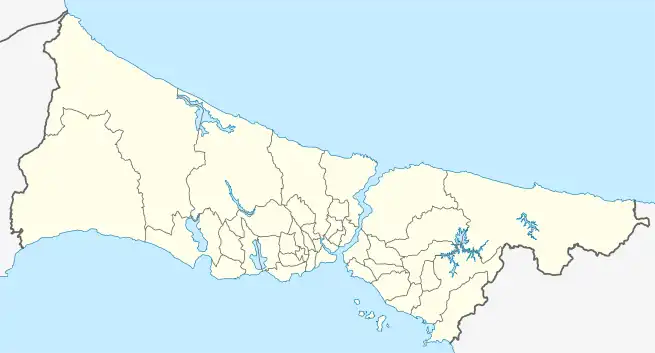New Rome
New Rome (Greek: Νέα Ῥώμη, Néa Rhṓmē; Koinē Greek: [ˈne̞a ˈr̥o̞ːme̞ː]; Latin: Nova Roma; Late Latin: [ˈnɔwa ˈroma]) was the original name given by the Roman emperor Constantine the Great in 330 CE[1] to his new imperial capital, which was built as an expansion of the city of Byzantium on the European coast of the Bosporus strait.
 Shown within Istanbul  New Rome (Marmara)  New Rome (Turkey) | |
| Alternative name | Byzantion (earlier Greek name) |
|---|---|
| Location | Fatih, Istanbul, Turkey |
| Region | Marmara Region |
| Coordinates | 41°0′50″N 28°57′20″E |
| Type | Imperial city |
| Part of | Roman Empire |
| Area | 6 km2 (2.3 sq mi) enclosed within Constantinian Walls |
| History | |
| Builder | Constantine the Great |
| Founded | 11 May 330 |
| Periods | Late antiquity |
| Cultures | |
The city was founded as Byzantion (Greek: Βυζάντιον) by Megarian colonists in 657 BCE.[1] It was renamed by Constantine the Great first as "New Rome" (Nova Roma) during the official dedication of the city as the new Roman capital in 330 CE,[1] which he soon afterwards changed to Constantinople (Constantinopolis).[1][2] The city was officially renamed as Istanbul in the 20th century, after the establishment of the Turkish Republic in 1923.
Constantine essentially rebuilt the city on a monumental scale from 326[3] to 330, partly modeling it after Rome. Names of this period included ἡ Νέα, δευτέρα Ῥώμη, "the New, second Rome";[4] Ἄλμα Ῥώμα, "Alma Roma"; Βυζαντιάς Ῥώμη, "Byzantine Rome"; ἑῴα Ῥώμη, "Eastern Rome"; and Roma Constantinopolitana.[3]: 354
The term "New Rome" was used to indicate that Byzantium, thereafter Constantinople, was the second/new capital of the Roman Empire. In modern times, "New Rome" remains part of the official title of the Orthodox Ecumenical Patriarch of that city.[5]
During the Tetrarchy system established by Diocletian in the 3rd century, Nicomedia (modern İzmit) near Istanbul was the Eastern (and most senior) capital of the Roman Empire (Diocletian had his seat in Nicomedia as the Augustus of the East). The last Roman co-emperor in Nicomedia, Licinius, was defeated by Constantine at the Battle of Chrysopolis (in the modern Üsküdar district on the Asian side of Istanbul) on 18 September 324. Constantine used Nicomedia as his interim capital city between 324 and 330, while rebuilding and expanding Byzantium as Nova Roma (which he soon renamed again as Constantinopolis).[1] Constantine died at a villa near Nicomedia on 22 May 337.
See also
References
- "Istanbul". britannica.com. Encyclopædia Britannica.
- Mango, Cyril (1991). "Constantinople". In Kazhdan, Alexander (ed.). The Oxford Dictionary of Byzantium. Oxford and New York: Oxford University Press. pp. 508–512. ISBN 0-19-504652-8.
- Georgacas, Demetrius John (1947). "The Names of Constantinople". Transactions and Proceedings of the American Philological Association. The Johns Hopkins University Press. 78: 347–67. doi:10.2307/283503. JSTOR 283503.
- The 5th-century church historian Socrates of Constantinople writes in his Historia Ecclesiastica, 1:16 (c. 439) that the emperor named the city "Constantinople" while decreeing that it be designated a "second Rome" (‘Κωνσταντινούπολιν’ μετονομάσας, χρηματίζειν ‘δευτέραν Ῥώμην’ νόμῳ ἐκύρωσεν).
- "Bartholomew, Archbishop of Constantinople, New Rome and Ecumenical Patriarch".